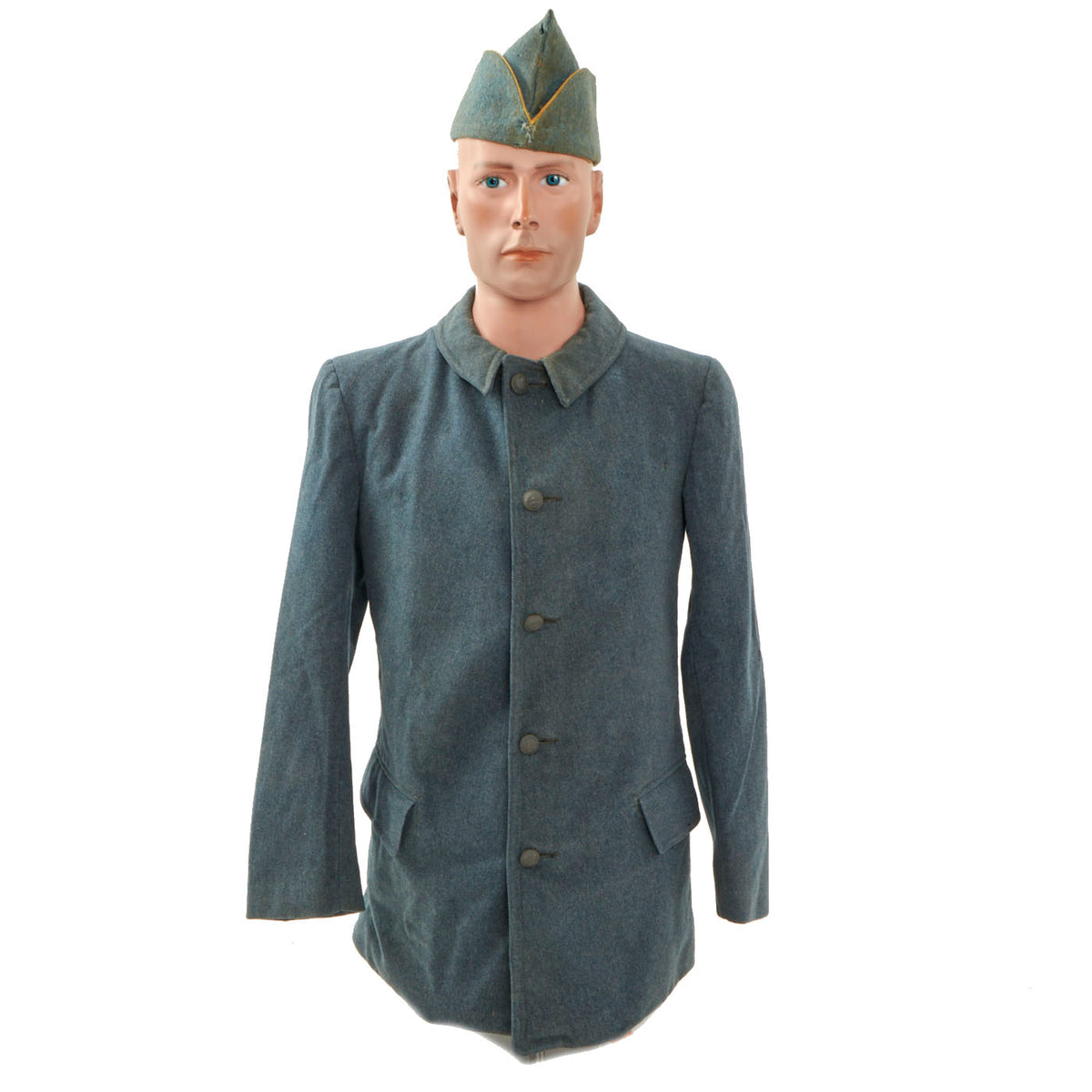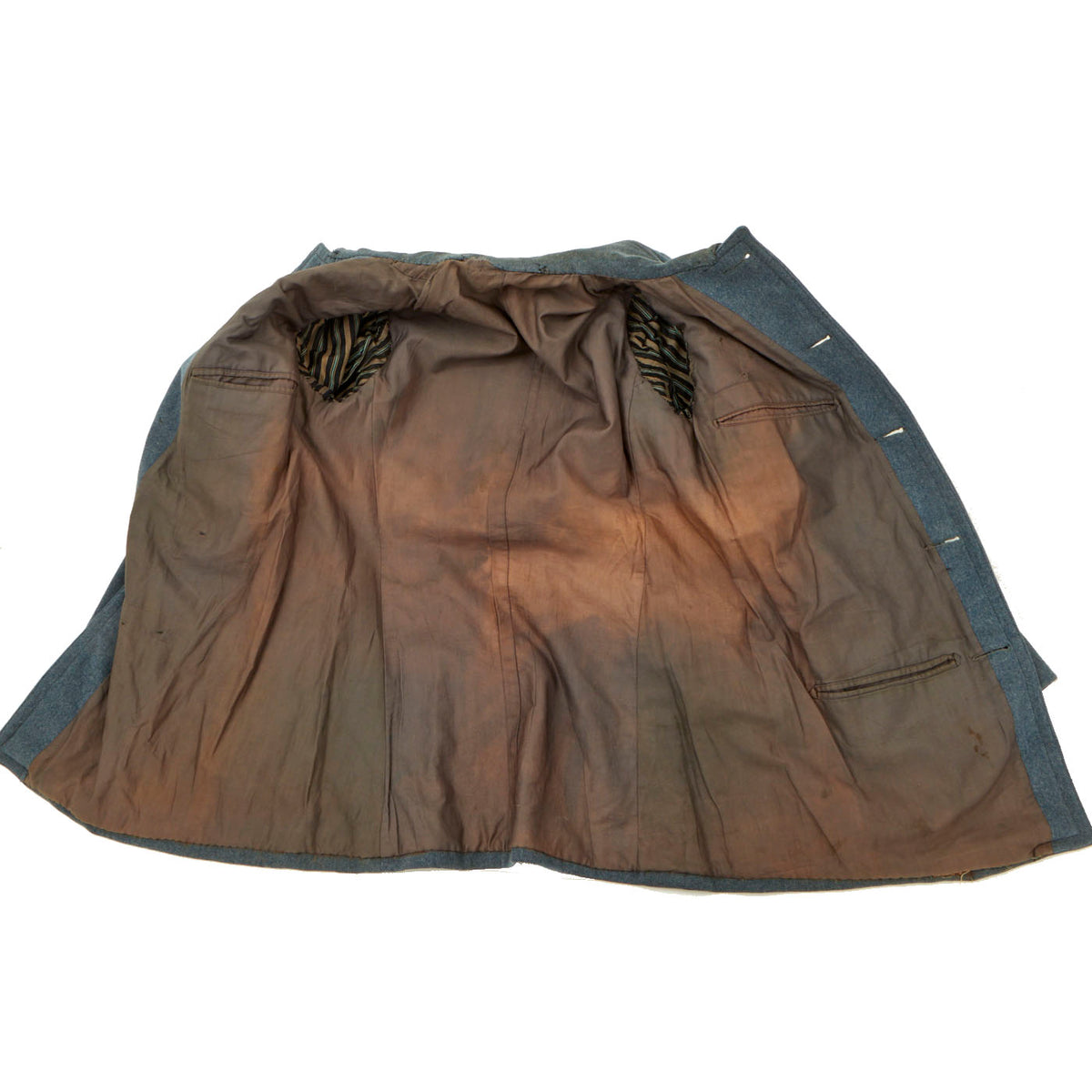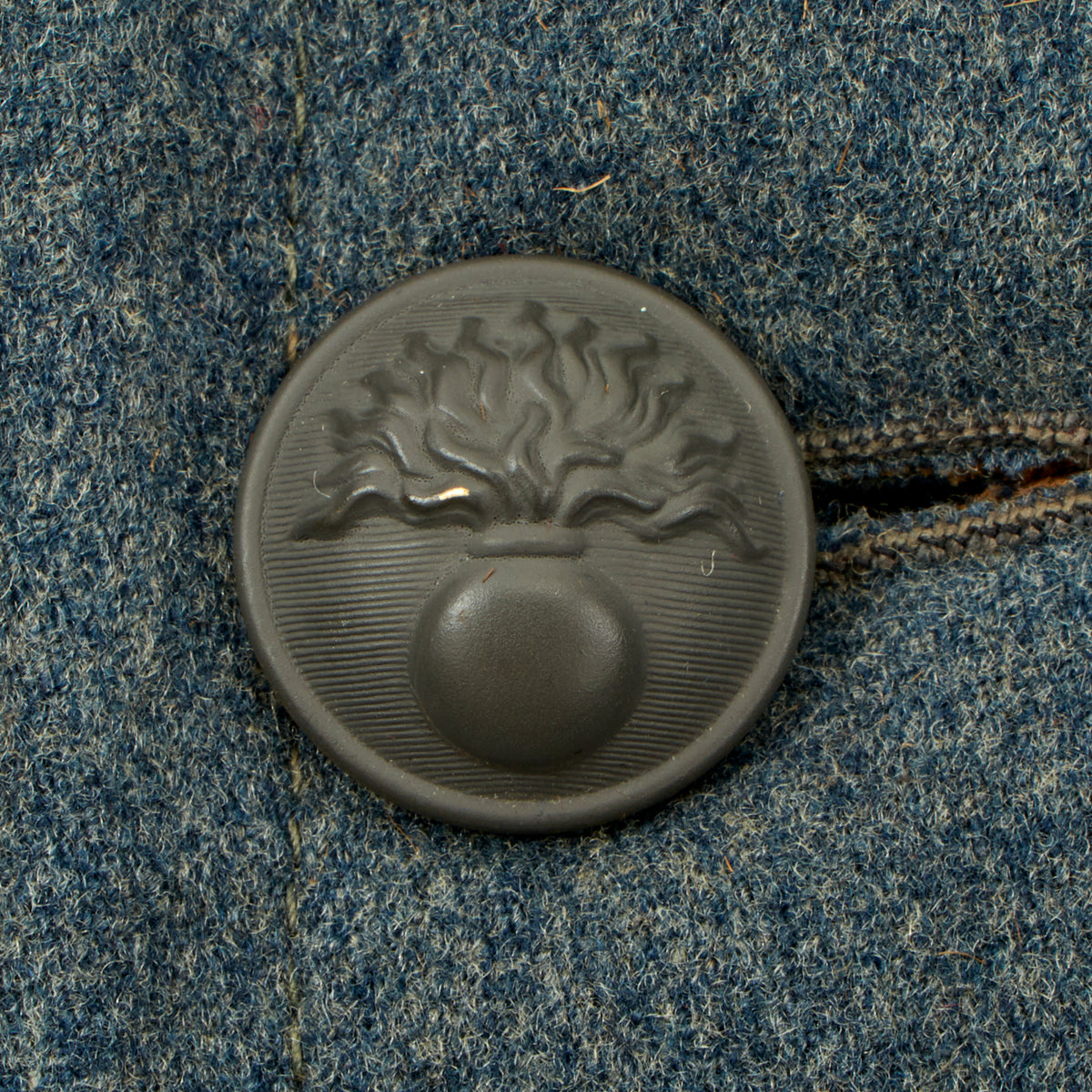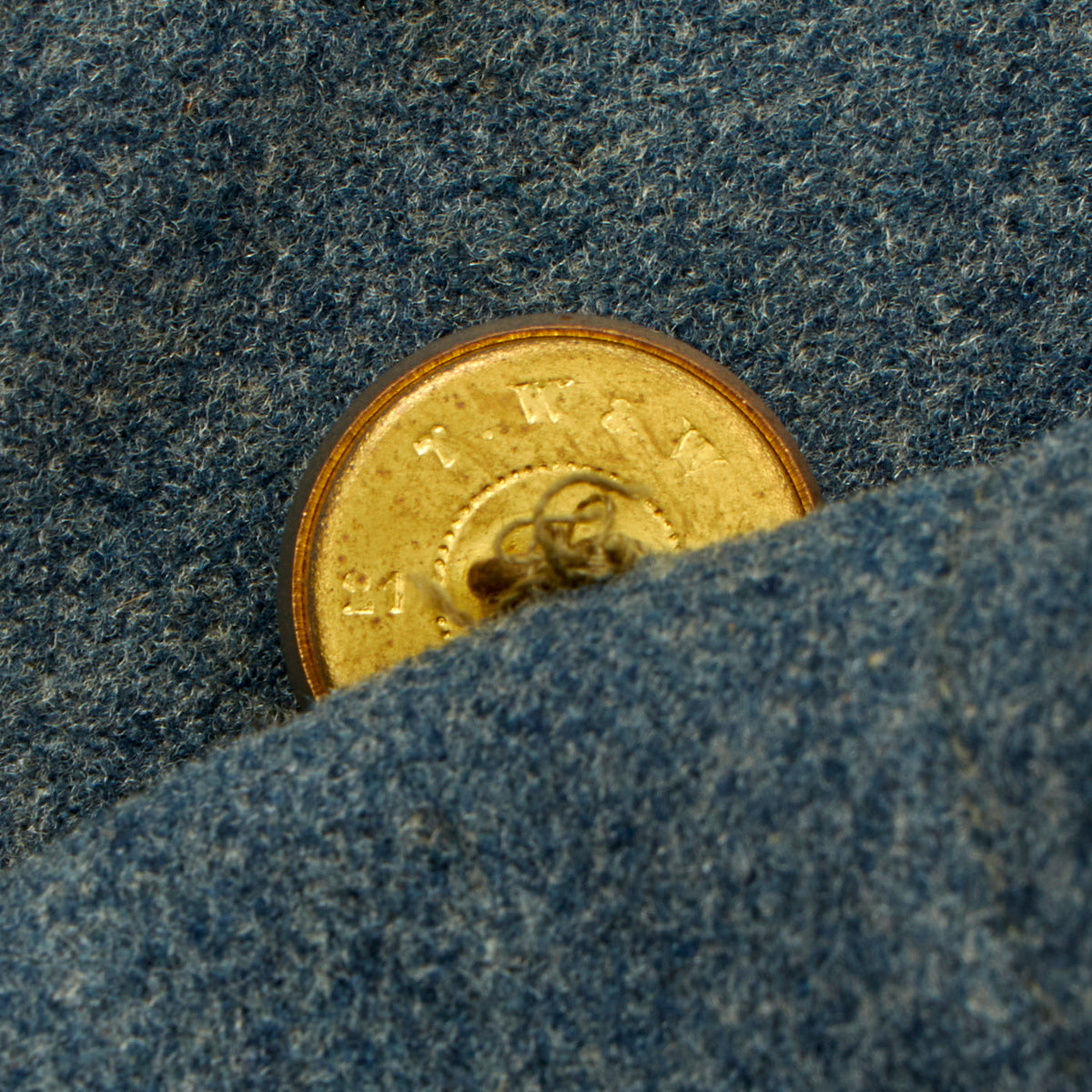Original French WWI Horizon Blue Combat Tunic and Garrison Cover Original Items
$ 695,00 $ 208,50
Original Item: Only One Set Available. Horizon blue is a color name which is well remembered because it was used for the blue-gray uniforms of French metropolitan troops from 1915 through 1921.
This name for a shade of blue which refers to the indefinable color which separates the sky from the earth, had been previously used in the world of fashion, and has been since then. It had also served as an emblem of political groups prevailing upon the army of the Great War.
The expression “horizon color” is found in diverse descriptions in and after 1895. In 1899, the Journal des débats pointed out that the motor boats destined for the administrators of the Cayenne convict prison were “painted in horizon color, to conceal them more easily”.
The color of the uniform of the French infantry became known as “horizon blue” in three steps:
1. The first orders at the end of 1914 designated a new uniform cloth as “light blue”.
2. On 16 January 1915, an article of L’Illustration designated the color of the uniform of the soldiers as “horizon color”. On the 26th, Le Matin likened this color to horizon blue. In February, the newspaper Le Temps compared the old and new uniforms: “The dark cloth of the old overcoats is seen side by side with the light azure of the new “horizon color” uniform. In the Spring of 1915, the expression was popularized. Becoming insensibly horizon blue, it was in general usage in September. It would never become an official term.
3. The expression became so popular that it was found in official descriptions of the army. The employment of “horizon blue cloth” instead of “light blue” can be explained notably by the fact that this expression possessed a national character and seemed “to echo the famous blue line of the Vosges.” However, regulations continued to name the uniform cloth as “light blue cloth” until 1921 and even beyond.
This is a lovely set consisting of a single breasted wool tunic and overseas cover. The tunic is one of the best condition ones that we have seen and presents minimal moth nips and is free of damage. There is no unit markings or names present unfortunately, or manufacturer information. All 5 buttons are free of damage and even still have almost all of the original finish present, something rarely seen. The overseas cover shows signs of extensive use, wear and steaning. Unfortunately there are quite a bit of moth nips.
This is truly a wonderful set! Comes ready to be displayed.
During World War I, France was one of the Triple Entente powers allied against the Central Powers. Although fighting occurred worldwide, the bulk of the conflict in Europe occurred in Belgium, Luxembourg, France and Alsace-Lorraine along what came to be known as the Western Front, which consisted mainly of trench warfare. Specific operational, tactical, and strategic decisions by the high command on both sides of the conflict led to shifts in organizational capacity, as the French Army tried to respond to day-to-day fighting and long-term strategic and operational agendas. In particular, many problems caused the French high command to re-evaluate standard procedures, revise its command structures, re-equip the army, and to develop different tactical approaches.
France had been the major power in Europe for most of the Early Modern Era: Louis XIV, in the seventeenth century, and Napoleon I in the nineteenth, had extended French power over most of Europe through skillful diplomacy and military prowess. The Treaty of Vienna in 1815 confirmed France as a European power broker. By the early 1850s, Prussian Chancellor Otto von Bismarck started a system of alliances designed to assert Prussian dominance over Central Europe. Bismarck’s diplomatic maneuvering, and France’s maladroit response to such crises as the Ems Dispatch and the Hohenzollern Candidature led to the French declaration of war in 1870. France’s subsequent defeat in the Franco-Prussian War, including the loss of its army and the capture of its emperor at Sedan, the loss of territory, including Alsace-Lorraine, and the payment of heavy indemnities, left the French seething and placed the reacquisition of lost territory as a primary goal at the end of the 19th century; the defeat also ended French preeminence in Europe. Following German Unification, Bismarck attempted to isolate France diplomatically by befriending Austria-Hungary, Russia, Britain, and Italy.
After 1870, the European powers began gaining settlements in Africa, with colonialism on that continent hitting its peak between 1895 and 1905. However, colonial disputes were only a minor cause of World War I, as most had been settled by 1914. Economic rivalry was not only a source for some of the colonial conflicts but also a minor cause for the start of World War I. For France, the rivalry was mostly with the rapidly industrializing Germany, which had seized the coal-rich region of Alsace-Lorraine in 1870, and later struggled with France over mineral-rich Morocco.
Another cause of World War I was growing militarism which led to an arms race between the powers. As a result of the arms race, all European powers were ready for war and had time tables that would send millions of reserves into combat in a matter of days.
France was bound by treaty to defend Russia. Austria-Hungary had declared war on Serbia due to the Black Hand’s assassination of Archduke Ferdinand, which acted as the immediate cause of the war. France was brought into the war by a German declaration of war on August 3, 1914.
Fast Shipping with Professional Packaging
Thanks to our longstanding association with UPS FedEx DHL, and other major international carriers, we are able to provide a range of shipping options. Our warehouse staff is expertly trained and will wrap your products according to our exact and precise specifications. Prior to shipping, your goods will be thoroughly examined and securely secured. We ship to thousands clients each day across multiple countries. This shows how we're dedicated to be the largest retailer on the internet. Warehouses and distribution centres can be located throughout Europe as well as the USA.
Note: Orders with more than one item will be assigned a processing date depending on the item.
Before shipping before shipping, we'll conduct a thorough inspection of the items you have ordered. Today, the majority of orders will be delivered within 48 hours. The delivery time will be between 3-7 days.
Returns
The stock is dynamic and we cannot completely manage it because multiple stakeholders are involved, including our factory and warehouse. So the actual stock may alter at any time. It's possible that you may not receive your order once the order has been made.
Our policy is valid for a period of 30 days. If you don't receive the product within 30 days, we are not able to issue a refund or an exchange.
You can only return an item if it is unused and in the same state as the day you received it. You must have the item in its original packaging.
Related products
Uncategorized
Uncategorized
Uncategorized
Uncategorized
Angolan Rebel 1970s era 60mm Inert Display Mortar from Angolan Civil War Original Items
Uncategorized
Uncategorized
Uncategorized
Uncategorized
Band of Brothers ORIGINAL GERMAN WWII Le. F.H. 18 10.5cm ARTILLERY PIECE Original Items
Uncategorized
Uncategorized
Uncategorized
Uncategorized
Uncategorized
Uncategorized













































































